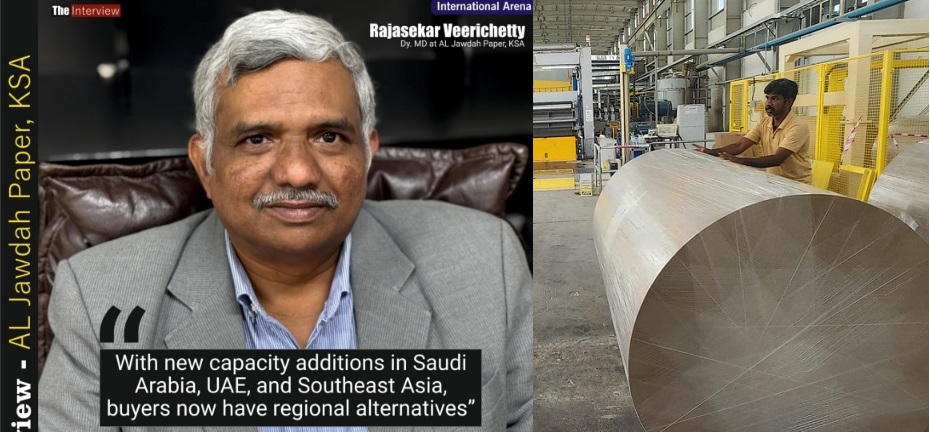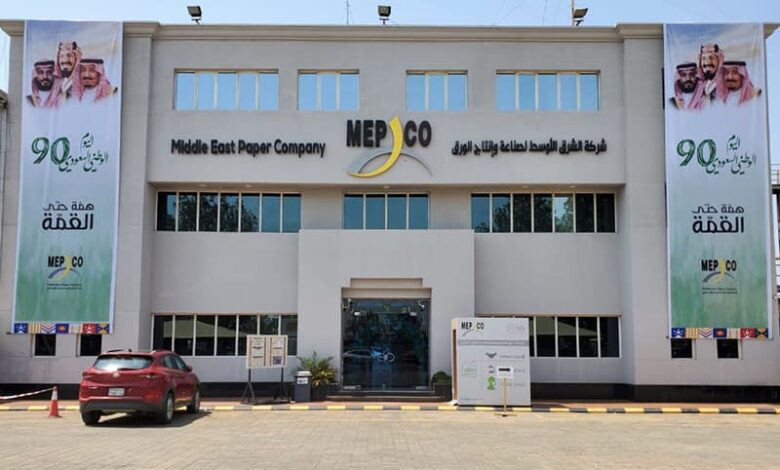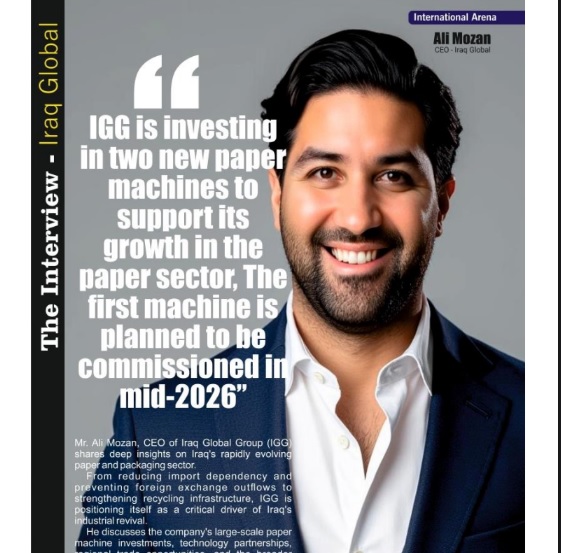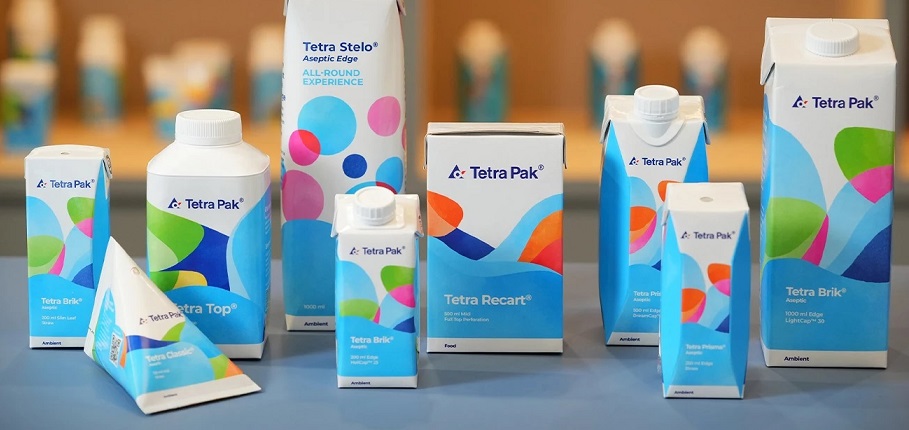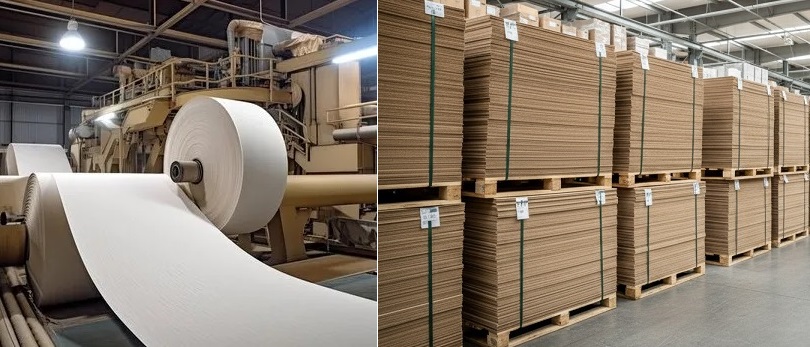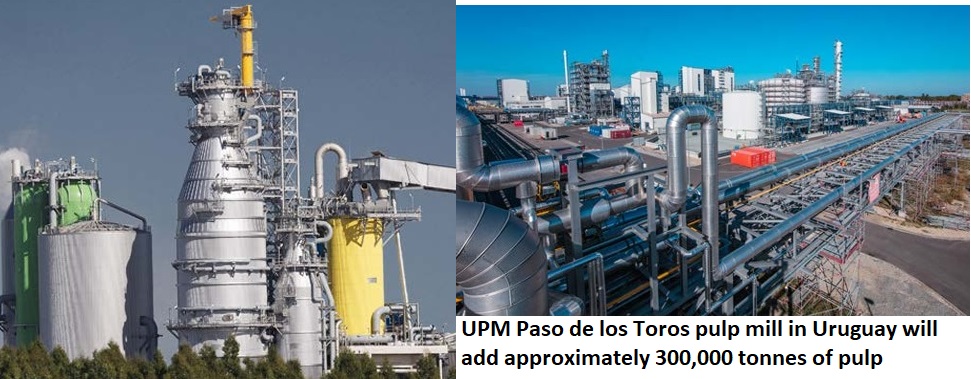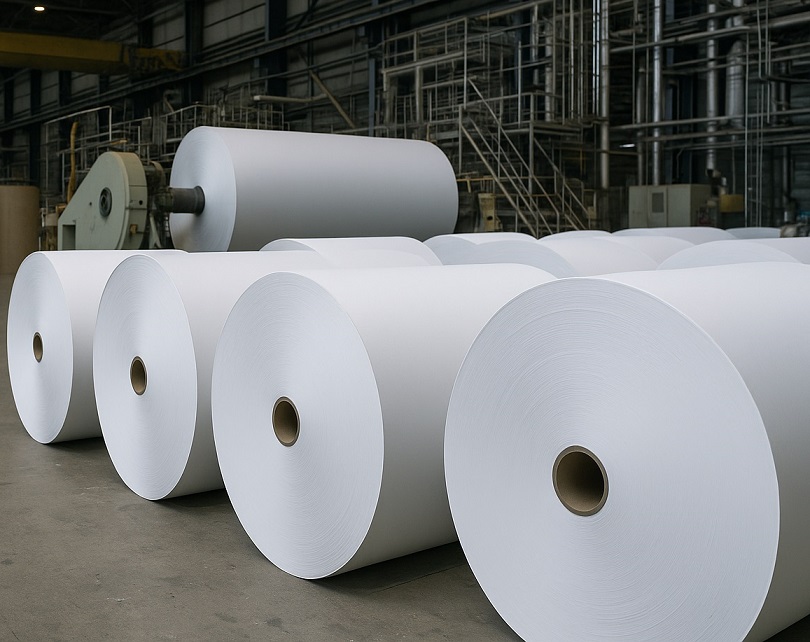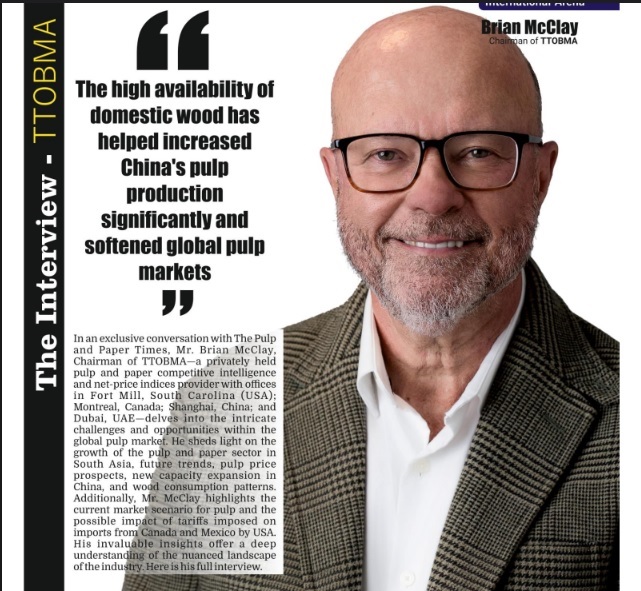“Demand for graphic paper in FY2024 will be 30% below; we continue to be faced with significant overcapacity necessitating extended periods of costly commercial downtime” says Mr. Steve Binnie CEO- SAPPI
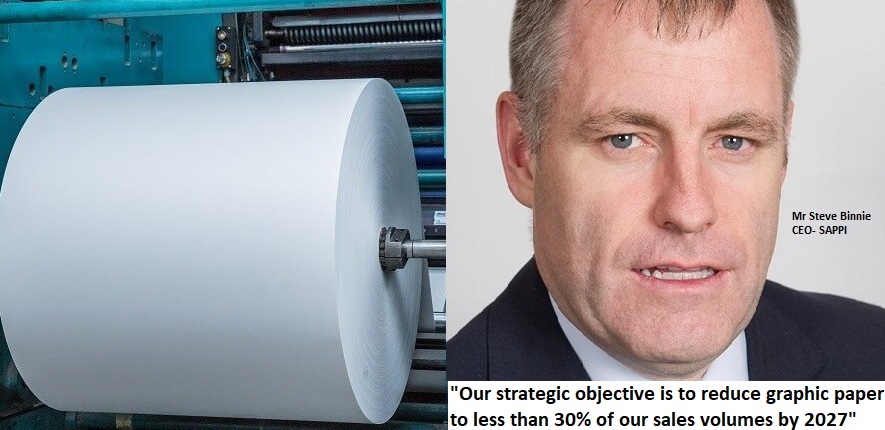
“Demand for graphic paper in FY2024 will be 30% below; we continue to be faced with significant overcapacity necessitating extended periods of costly commercial downtime” says Mr. Steve Binnie CEO- SAPPI
Key Points:
- We will rationalise our graphic paper capacity in Europe through closure of the Stockstadt Mill and potential closure of the Lanaken Mill.
- We continue to evaluate further opportunities to reduce our exposure to graphic paper through sale of assets or for potential conversion opportunities to packaging and speciality paper grades.
- The Somerset PM2 project will add 470,000 tpa of SBS capacity in 2025, which will double our market share.
“Our graphic papers markets faced significant challenges in 2023 due in part to an extended destocking cycle. In hindsight, the extraordinary surge in demand we experienced in 2022, which nearly reached pre-Covid-19 levels, included a significant element of forward buying by our customers.” He said.
The Pulp and Paper Times | The above interview has been extracted from SAPPI annual report for FY 2023.
Q: Graphic paper demand was extremely weak in 2023 necessitating widespread production curtailments across the industry. What is Sappi’s view of demand in 2024 and how will you address overcapacity?
Our graphic paper markets faced significant challenges in 2023 due in part to an extended destocking cycle. In hindsight, the extraordinary surge in demand we experienced in 2022, which nearly reached pre-Covid-19 levels, included a significant element of forward buying by our customers. The rebound in economic activity in 2022, coupled with severely constrained supply chains created a worldwide paper shortage. Against this backdrop of volatile and uncertain global logistics, customers increased their orders well beyond underlying demand levels. However, as macroeconomic conditions deteriorated and supply chains normalised late in 2022 our customers experienced a substantial increase in inventory. The subsequent destocking combined with weak global macroeconomics led to a material decline in demand for graphic paper which persisted throughout FY2023.
The historical rate of decline for graphic paper was approximately 6% per annum. Taking this trajectory into account and considering the demand rebound in 2022 to almost 2019 levels, demand in 2023 should have been approximately 25% below that of 2022. However, sales volumes for our graphic papers segment in FY2023 declined by 38% year-on-year, which necessitated widespread production curtailments in our European and North American operations. While the extent of the demand weakness can be partially attributed to the destocking cycle, graphic paper markets continue to remain subdued, particularly in Europe. This suggests that there has been an accelerated decline and a permanent erosion of demand that is unlikely to return. Order activity has improved slightly in recent months, indicating a modest recovery, but our fundamental assumption is that demand for graphic paper in FY2024 will be 30% below FY2022 levels.
With this anticipated level of demand, we continue to be faced with significant overcapacity necessitating extended periods of costly commercial downtime. Recognising these low operating rates are unsustainable and aligned with our strategy to reduce exposure to graphic paper markets, we will proactively manage overcapacity. In the short term, we will rationalise our graphic paper capacity in Europe through closure of the Stockstadt Mill and potential closure of the Lanaken Mill. This will remove approximately 750,000 tpa (~30%) of our European graphic paper capacity in FY2024, which will significantly improve the utilisation of our remaining graphic paper assets and improve the fixed cost position of the business in the second half of the year. We are confident that we can shift the current sales volumes to our other assets. Over the medium term, our conversion and expansion of Somerset PM2 to solid bleached sulphate paperboard will remove 235,000 tpa (~ 30%) of our North American graphic paper capacity in 2025. Furthermore, the project at our Gratkorn Mill in Europe to expand our label paper capability will displace a further 200,000 tpa of graphic paper. Through these actions, we will proactively reduce our graphic paper capacity to match declining demand and in so doing ensure that our assets are fully utilised generating cash. We continue to evaluate further opportunities to reduce our exposure to graphic paper through sale of assets or for potential conversion opportunities to packaging and speciality paper grades. Our strategic objective is to reduce graphic paper to less than 30% of our sales volumes by 2027.
Q: Has the demand weakness in packaging and speciality papers segment in FY2023 altered your long-term view on growth projections? Is there any impact on the investment case and timing of the Somerset conversion and expansion project?
The packaging and speciality papers segment faced weak trading conditions related to high levels of downstream inventory and muted consumer demand in FY2023. The destocking process is taking longer than anticipated but all indicators point to normalisation of inventories within our value chains early in FY2024. The macroeconomic landscape, however, remains unpredictable, which is likely to continue to weigh on consumer sentiment in the short term as some of our packaging and speciality papers are linked to discretionary consumer goods. Nevertheless, our long-term favourable outlook for our sustainably produced packaging and speciality paper products remains unchanged. Paperbased packaging offers a myriad of environmental sustainability and functionality benefits. Our low-carbon, renewable and circular packaging products, derived from responsibly managed forests and deforestation-free supply chains, offer consumers a more environmentally friendly choice compared to non-renewable alternatives. As industries and consumers increasingly prioritise sustainability, the benefits of paper-based packaging align with these values, making it a compelling and responsible choice for packaging solutions.
The short-term macroeconomic pressures on consumer sentiment have not altered our investment case for the conversion and expansion of our Somerset PM2 machine to solid bleached sulphate paperboard and we remain on track for commissioning in mid-2025. Our folding carton paperboard products are particularly versatile and allow for exceptional print quality that enhances creative design and brand visibility for luxury beverages, cosmetics and perfumes, health and beauty care and consumer electronics. Furthermore, demand for food service board grades for disposable cups, plates and fast food packaging continues to grow as the industry responds to consumer and legislative pressures to switch from fossil-based products. Our conservative market growth assumption of 2% per annum remains unchanged and excludes the potential growth opportunities based on substitution of fossil-based packaging.
There have been a number of capacity closures in the North American paperboard market during 2023, which we estimate reduces solid bleached sulphate paperboard capacity by approximately 7%. While some of the capacity exiting the market is in areas such as liquid packaging where we do not currently compete, we believe the overall impact is positive and tightens the market ahead of our Somerset expansion. In addition, one of our peers has reported that they will not make a decision on the conversion of a graphic paper asset to paperboard by the end of 2023 as previously announced, which further extends the timeline for additional capacity entering the North American market. The Somerset PM2 project will add 470,000 tpa of SBS capacity in 2025, which will double our market share. Sappi is well positioned to benefit from the demand growth for paperboard in North America and our anticipated returns on the investment are expected to exceed a 20% internal rate of return (IRR).
Q: Sappi’s capital expenditure is expected to increase over the next two years as you expand the packaging capacity at Somerset Mill. Should investors be concerned about debt levels in 2024?
Despite 2023 being one of the most challenging downcycles experienced in the pulp and paper industry, with demand for our paper products falling below that of the Covid-19 pandemic years, we continued to generate significant cash which enabled a further reduction of net debt at year-end to US$1,085 million, the lowest level in 30 years. This was after taking into account a negative currency translation effect on our Euro-denominated debt being converted at a higher rate, which increased net debt by US$76 million for the year, and the US$107 million returned to shareholders through the dividend and share buyback programmes. Our strategic focus on sustaining our financial health through disciplined capital allocation and a strong emphasis on cash generation has materially repositioned our balance sheet over the last two years.
The significantly lower debt profile and healthy cash reserves provide us with flexibility to navigate the headwinds of cyclical downturns and have allowed us to begin the next phase of investments for growth in our target markets with the conversion and expansion of Somerset PM2 to solid bleached sulphate paperboard. In line with our disciplined approach to capital allocation, we will proactively manage cash flows by phasing the US$418 million capital expenditure for the Somerset PM2 project over three years (US$100 million FY2023, US$154 million FY2024 and US$164 million FY2025). Maintaining our existing operations and improving our environmental footprint is also a high-level priority and is a strategic investment in our existing assets to ensure future safe, efficient and sustainable operations. We anticipate capital expenditure will be in the region of US$500 million for the next two years, which includes the expansionary capex as outlined above together with maintenance and sustainability capex of approximately US$350 million per annum. We have no other large capital projects planned during this period. We have committed to returning value to our shareholders and declared a dividend of 15 US cents for FY2023, which will result in a cash outflow of approximately US$85 million in the second quarter of FY2024. We will also potentially incur closure and restructuring costs of approximately US$159 million for the closure of the Lanaken Mill. The fixed costs benefit of the restructuring will be partially realised in FY2024 and therefore we anticipate a net cash outflow for FY2024. In the short term, we anticipate our net debt will rise slightly from the FY2023 level but our commitment to our target of US$1 billion remains intact and we are confident that our strategic actions to reduce our graphic paper exposure and grow our packaging business will enhance our future cash generation and improve profitability of our business.
Q: New sustainability and environmental, social and governance (ESG) regulations have been legislated in Europe and globally ESG reporting expectations are rapidly expanding. How is Sappi responding?
ESG reporting is crucial in today’s business landscape as it serves as a fundamental tool for companies to communicate their commitment to sustainable and responsible business practices. By disclosing information on environmental impact, social responsibility and governance structures, we not only enhance transparency but also build trust among stakeholders, including investors, customers, employees and the broader community. The ESG reporting landscape has undergone a rapid and transformative evolution over the last few years, reflecting a paradigm shift in corporate consciousness and stakeholder expectations. In recent times, the landscape has witnessed a remarkable mainstreaming of ESG considerations. Governments, regulatory bodies and stock exchanges around the world have increasingly recognised the importance of ESG disclosure, establishing guidelines and frameworks to standardise reporting practices. Simultaneously, investors have recognised the material impact of ESG factors on financial performance and risk management, driving a surge in demand for comprehensive and comparable ESG data. As a result, ESG reporting has transitioned from a voluntary initiative to a critical component of corporate governance, risk management and strategic decision-making, illustrating a broader recognition of the connection between sustainability and long-term business success.
As a company committed to environmental stewardship, social responsibility and sound governance practices, transparency serves as a cornerstone of our Thrive strategy. Transparent reporting on key ESG metrics not only aligns with Sappi’s values but also allows our stakeholders to make informed decisions. Ultimately, for Sappi, transparency is not just a compliance requirement but a strategic imperative that enhances our reputation, fosters long-term relationships and contributes to the company’s sustainable growth. We have for many years used the GRI framework for our ESG disclosures and more recently aligned our climate reporting with the Task Force on Climate-related Financial Disclosures (TCFD) framework. In addition, our CDP (formerly the Carbon Disclosure Project) responses to climate, forests and water are publicly available for stakeholder review. The new European Union’s Corporate Sustainability Reporting Directive (CSRD) went into force in January 2023. With our large European footprint, we will be classified as a company headquartered outside the EU operating in the region subject to the CSDR and therefore plan to align with the European Sustainability Reporting Standards (ESRS) for our FY2025 annual reporting period. Based on the high level of interoperability between GRI and ESRS and our comprehensive CDP disclosures, we are well placed to adopt these new standards.
The above interview has been extracted from SAPPI's annual report for FY 2023.
Web Title: “Demand for graphic paper in FY2024 will be 30% below; we continue to be faced with significant overcapacity necessitating extended periods of costly commercial downtime” says Mr Steve Binnie CEO- SAPPI





 Join WhatsApp Group
Join WhatsApp Group Join Telegram Channel
Join Telegram Channel Join YouTube Channel
Join YouTube Channel Join Job Channel (View | Submit Jobs)
Join Job Channel (View | Submit Jobs) Join Buy Sell Channel (Free to Submit)
Join Buy Sell Channel (Free to Submit) Paper News Headlines Channel (Free to read)
Paper News Headlines Channel (Free to read)




